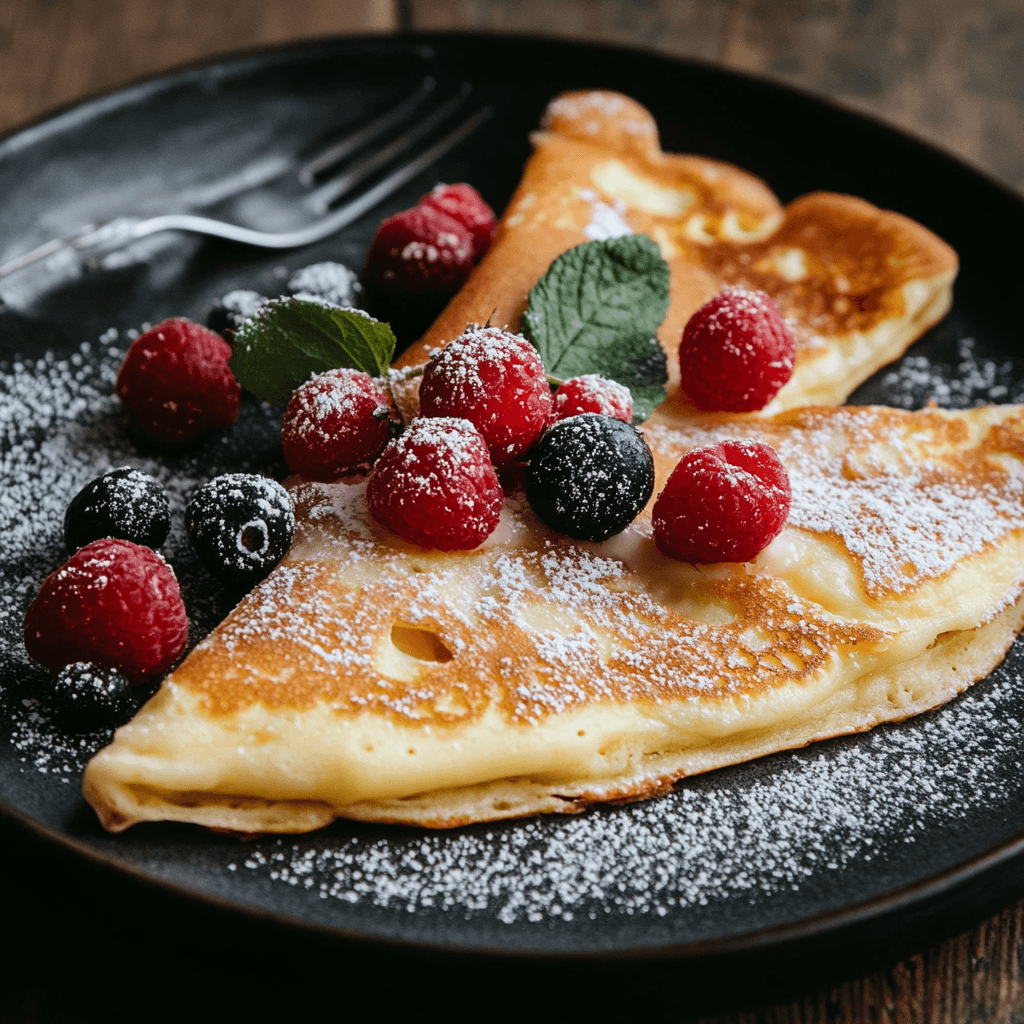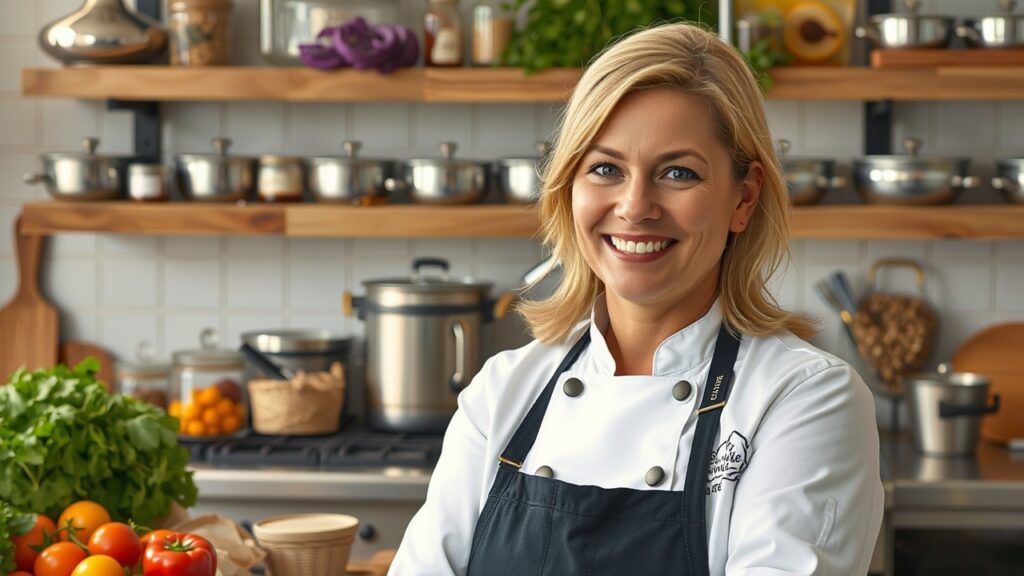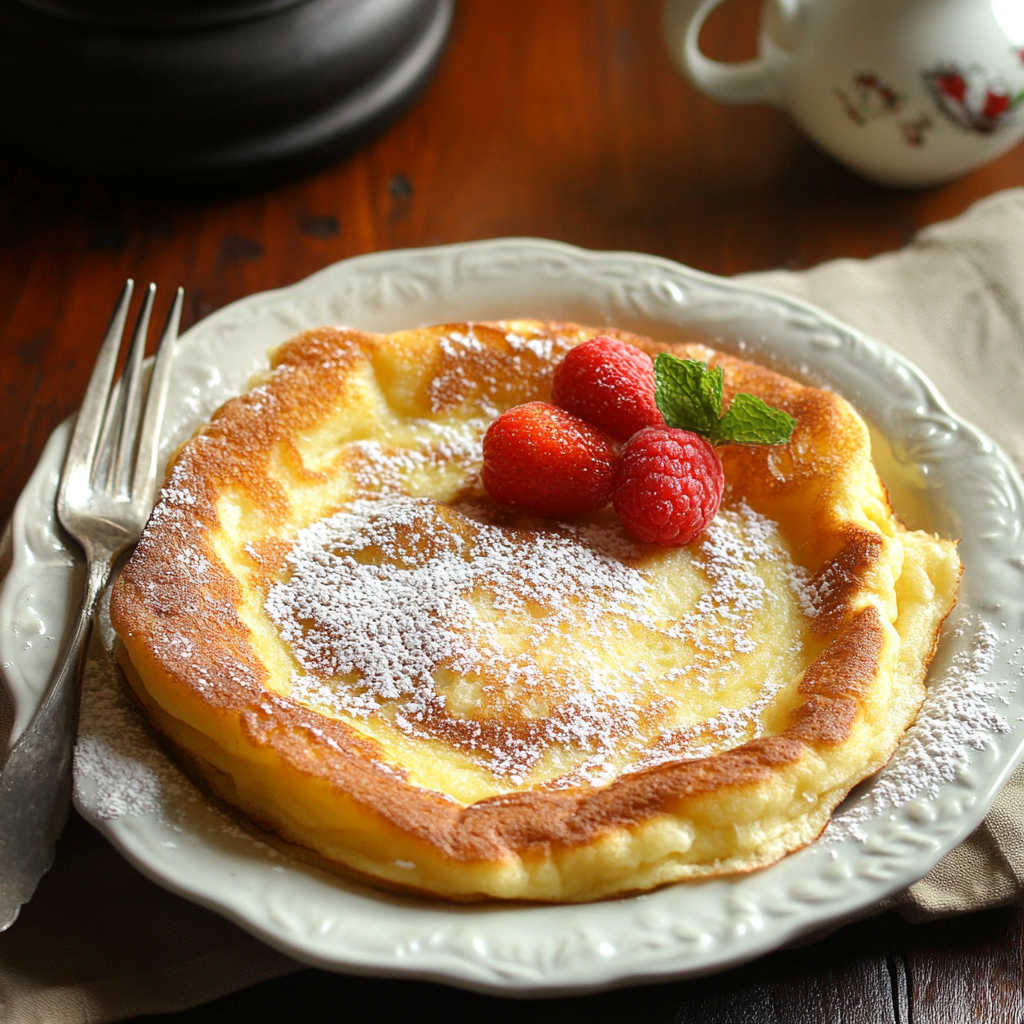Introduction to German Pancakes
What Are German Pancakes?
When it comes to a delightful and easy breakfast, few dishes compare to a classic German pancake recipe. Known for its light, airy texture and versatile flavor, this dish is also called a “Dutch baby.” Whether you enjoy it sweet or savory, this puffy pancake recipe will become a family favorite.
History and Origins of the Dish
The origins of German pancakes are not strictly German; the dish is believed to have evolved from European-style pancakes. The name “Dutch baby” is said to be an Americanized version of “Deutsch,” referring to the German roots of its creators. Popularized in the United States in the early 1900s, German pancakes gained fame through restaurants like Manca’s Café in Seattle, making it a beloved breakfast classic.
How German Pancakes Differ from Regular Pancakes
While regular pancakes are cooked on a griddle and are flat and fluffy, German pancakes are baked in the oven and feature a unique puffed-up texture. They rely heavily on the steam created in the batter during baking, which contributes to their airy structure. Additionally, German pancakes have a more custard-like consistency compared to the cakey texture of regular pancakes.
Why German Pancakes Are a Must-Try
Unique Taste and Texture
This German pancake recipe offers a unique combination of crispy edges and a custard-like center, making it perfect for any meal of the day. Unlike traditional pancakes, this oven pancake recipe is baked in the oven, creating its signature puff. It’s ideal for breakfast, brunch, or even dessert, especially when paired with fresh fruit or savory toppings.
Perfect for Breakfast or Dessert
German pancakes are incredibly versatile. They can be a comforting breakfast served with powdered sugar and fresh fruit or a decadent dessert topped with whipped cream, chocolate, or caramel. Their adaptability makes them suitable for any occasion.
Customizable Toppings and Variations
One of the highlights of German pancakes is their ability to adapt to your preferences. From classic toppings like lemon juice and powdered sugar to adventurous options like Nutella, seasonal fruits, or even savory additions like cheese and herbs, the possibilities are endless.
Essential Ingredients
Core Ingredients Explained
The core ingredients for German pancakes include:
- Eggs: The primary ingredient that gives the pancake its rich flavor and airy structure.
- Milk: Adds moisture and contributes to the custard-like consistency.
- Flour: Provides structure and helps the pancake hold its shape.
- Butter: Used to grease the pan, it adds a golden crust and enhances the flavor.
- Salt and Sugar: These balance the flavor, with sugar adding a hint of sweetness.
Substitutions for Dietary Restrictions
- Gluten-Free: Substitute all-purpose flour with a gluten-free blend.
- Dairy-Free: Use plant-based milk (like almond or oat milk) and vegan butter or coconut oil.
- Sugar-Free: Replace sugar with natural sweeteners like stevia or monk fruit.
Ingredient Quality Tips
For the best results, use high-quality, fresh ingredients. Organic eggs and milk can enhance the richness, while fresh, unbleached flour ensures a better texture. Additionally, opt for unsalted butter to control the saltiness of the dish.
Tools and Equipment Needed
Essential Kitchen Tools
To make German pancakes, you’ll need the following essential tools:
- Oven-Proof Skillet or Baking Dish: A cast-iron skillet is ideal for achieving the signature crispy edges, but any oven-safe pan or dish will work.
- Whisk or Blender: To mix the batter thoroughly and ensure it is lump-free.
- Mixing Bowl: A medium-sized bowl for combining the ingredients.
- Measuring Cups and Spoons: For precise measurements of ingredients.
- Spatula: To loosen the pancake from the pan if necessary.
Alternatives for Missing Tools
- If you don’t have an oven-proof skillet, use a pie dish or casserole dish instead.
- No whisk? A fork or an immersion blender can work as a substitute to mix the batter.
- If you lack measuring tools, use standard cups and spoons but keep the proportions consistent.
Best Practices for Preparation
- Preheat Your Oven: Ensuring the oven and skillet are preheated is critical for the batter to rise properly.
- Use Room-Temperature Ingredients: Eggs and milk at room temperature help the batter blend evenly and rise better.
- Grease the Pan Well: Generously coat the pan with butter to prevent sticking and to add flavor.
Step-by-Step German Pancake Recipe
Preparation
- Making a German pancake recipe is simple and fun! Follow these steps to enjoy your own fluffy Dutch baby recipe:
- Preheat your oven to 425°F.
- Whisk together eggs, milk, flour, and a pinch of salt to create the batter.
- Pour the batter into a hot, buttered skillet and bake until puffed and golden.
- Serve this classic German pancake immediately with your favorite toppings for an irresistible treat.
Mixing the Batter
- Combine Ingredients: In a mixing bowl, whisk together eggs, milk, flour, sugar, and a pinch of salt until smooth. Alternatively, use a blender to achieve a lump-free, airy batter.
- Rest the Batter (Optional): Allow the batter to rest for 5-10 minutes to let the flour fully hydrate.
Baking to Perfection
- Prepare the Pan: Remove the hot skillet or dish from the oven and add a generous amount of butter. Swirl it around until fully melted and the pan is well-coated.
- Pour the Batter: Immediately pour the batter into the hot pan and return it to the oven.
- Bake: Bake for 20-25 minutes, or until the pancake is puffed and golden brown around the edges. Avoid opening the oven door during baking to prevent heat loss.
- Serve: Once out of the oven, serve immediately with your favorite toppings.
Common Mistakes to Avoid
Overmixing the Batter
Overmixing can lead to a dense pancake instead of the desired airy texture. Mix just until the ingredients are combined and smooth.
Incorrect Oven Temperature
An oven that is too hot or not preheated properly can cause uneven puffing or burning. Use an oven thermometer if possible to ensure accuracy.
Timing the Baking Process
Underbaking will result in a soggy center, while overbaking can make the pancake dry and chewy. Keep a close eye on the pancake during the last few minutes and remove it when it’s golden and puffed.
Creative Topping Ideas
Sweet Toppings
- Powdered Sugar and Lemon Juice: A classic combination that adds a sweet and tangy flavor.
- Fresh Fruits: Top with berries, sliced bananas, or diced apples for a refreshing twist.
- Maple Syrup or Honey: Drizzle these over your pancake for a rich and natural sweetness.
- Chocolate or Caramel Sauce: Perfect for a decadent dessert option.
- Whipped Cream: Add a dollop for an indulgent finishing touch.
Savory Toppings
- Cheese and Herbs: Sprinkle grated Parmesan or cheddar with fresh herbs like chives or parsley.
- Avocado and Smoked Salmon: A gourmet twist for a savory breakfast or brunch.
- Fried Eggs and Bacon: A hearty option for those who love traditional breakfast flavors.
- Sautéed Vegetables: Use spinach, mushrooms, or bell peppers for a healthier, veggie-packed choice.
Seasonal and Festive Options
- Autumn Delight: Top with spiced apples, cinnamon, and a drizzle of caramel for a fall-inspired treat.
- Winter Warmth: Cranberry sauce and a dusting of powdered sugar make it perfect for the holidays.
- Spring Freshness: Fresh strawberries, rhubarb compote, or edible flowers celebrate springtime.
- Summer Vibes: Tropical fruits like mango, pineapple, and coconut flakes evoke a summery feel.

Nutritional Information
Caloric Breakdown
The calorie count for a serving of German pancake (without toppings) generally falls between 250-350 calories, depending on the proportions of butter, eggs, and milk used. Adding toppings will increase the calorie count, so choose them wisely based on your dietary needs.
Macronutrient Details
- Protein: German pancakes are high in protein due to the eggs, with one serving providing around 8-12 grams.
- Carbohydrates: The flour contributes to a moderate carbohydrate count, roughly 25-35 grams per serving.
- Fats: Butter and milk add healthy fats, averaging 10-15 grams per serving. Adjust butter amounts or use low-fat milk to reduce fat content.
Healthier Versions
- Low-Calorie: Use skim milk and reduce butter to cut calories without compromising taste.
- High-Protein: Add a scoop of protein powder to the batter or increase the egg content.
- Gluten-Free: Substitute regular flour with almond or oat flour for a gluten-free alternative.
- Sugar-Free: Replace sugar with natural sweeteners like stevia or monk fruit for a low-sugar option.
- Dairy-Free: Use plant-based milk like almond or oat milk and replace butter with coconut oil.
By customizing toppings and ingredients, German pancakes can fit a wide range of dietary preferences and nutritional goals.
Frequently Asked Questions (FAQs)
What Is the Best Way to Serve German Pancakes?
The best way to serve German pancakes is straight out of the oven while they are still puffed and warm. They pair beautifully with a dusting of powdered sugar and a squeeze of lemon juice, but you can customize them with toppings like fresh fruit, syrups, whipped cream, or even savory ingredients like cheese and bacon.
Can German Pancakes Be Made Gluten-Free?
Yes, German pancakes can easily be made gluten-free by substituting all-purpose flour with gluten-free alternatives such as almond flour, oat flour, or a gluten-free flour blend. Ensure the substitute flour has a fine texture for a smooth batter.
What Is the Difference Between German Pancakes and Regular Pancakes?
The main differences are in preparation and texture:
- Cooking Method: German pancakes are baked in the oven, while regular pancakes are cooked on a stovetop.
- Texture: German pancakes are airy, with crisp edges and a custard-like interior, while regular pancakes are soft and fluffy throughout.
- Shape: German pancakes puff up dramatically in the oven, forming irregular, bowl-like edges, unlike the flat, circular shape of regular pancakes.
What Is a German Pancake Made Of?
German pancakes are made from a simple batter that typically includes:
- Eggs
- Milk
- Flour
- Sugar
- Butter
- A pinch of salt
The batter is poured into a hot, buttered skillet and baked to create a golden, puffed-up pancake.
What Is the Most Delicious Pancake in the World?
The title of the most delicious pancake depends on personal preference. German pancakes are renowned for their unique texture and versatility. Other contenders might include fluffy Japanese soufflé pancakes, rich French crêpes, or the hearty American stack drizzled with maple syrup.
Why Are My German Pancakes Flat?
Flat German pancakes are often the result of one or more of the following issues:
- Cold Ingredients: Using cold eggs or milk can prevent the batter from puffing up properly. Always use room-temperature ingredients.
- Underheated Pan or Oven: Preheat the skillet and oven thoroughly before adding the batter.
- Overmixing the Batter: Too much mixing can develop gluten in the flour, making the batter too dense to rise.
- Opening the Oven Door: Avoid opening the oven during baking, as it can cause the temperature to drop and deflate the pancake.
Serving Suggestions
Pairing German Pancakes with Beverages
- Coffee or Espresso: A rich, hot coffee or a shot of espresso complements the buttery and slightly sweet flavor of German pancakes perfectly.
- Freshly Squeezed Juice: Orange or grapefruit juice adds a refreshing and tangy note to balance the richness.
- Milk or Plant-Based Alternatives: A glass of cold milk, almond milk, or oat milk pairs well with both sweet and savory variations.
- Herbal Tea: Mild teas like chamomile or peppermint offer a soothing accompaniment for lighter breakfast servings.
Perfect Side Dishes
- Crispy Bacon or Sausages: Add a savory contrast to the soft, airy pancakes.
- Fresh Fruit Salad: A mix of berries, melon, and citrus brightens the plate and adds natural sweetness.
- Yogurt and Granola: Serve alongside for a creamy, crunchy, and nutritious side.
- Hash Browns or Roasted Potatoes: These add a hearty element, especially for savory versions of German pancakes.
Variations of German Pancakes
Mini German Pancakes
- What They Are: Individual-sized portions baked in muffin tins for a cute and convenient serving option.
- How to Make Them: Divide the batter into greased muffin cups and bake at 400°F (200°C) for 12-15 minutes, or until puffed and golden.
- Perfect For: Brunch gatherings, parties, or kid-friendly breakfasts.
Savory Spin on the Classic Recipe
- Cheesy Herb German Pancake: Add grated cheese, chopped herbs, and a pinch of garlic powder to the batter for a savory twist.
- Vegetable-Filled Pancake: Mix in sautéed spinach, onions, or mushrooms before baking.
- Ham and Cheese Delight: Add diced ham and shredded cheddar for a satisfying breakfast or brunch dish.
- Southwest Style: Top with salsa, avocado, and sour cream for a Tex-Mex-inspired version.
Storing and Reheating
How to Store Leftovers
- Cooling: Allow the pancake to cool completely before storing.
- Refrigeration: Place leftovers in an airtight container and store in the refrigerator for up to 2-3 days.
- Freezing: For longer storage, wrap individual portions in plastic wrap or foil and freeze for up to 1 month.
Tips for Reheating Without Losing Texture
- Oven Method: Preheat the oven to 350°F (175°C) and warm the pancake on a baking sheet for 5-7 minutes. This helps maintain its crisp edges.
- Stovetop Method: Heat a nonstick skillet over medium heat and reheat the pancake until warm and slightly crispy.
- Microwave Method: While faster, this can soften the pancake’s texture. Use low power and heat for 20-30 seconds to avoid overcooking.
- Topping Freshness: Add toppings like fruit or whipped cream after reheating to keep them fresh and flavorful.
Hosting a German Pancake Brunch
Menu Planning
- Main Dish: Feature German pancakes as the star of the menu, offering both sweet and savory toppings for variety.
- Side Dishes: Include complementary options like crispy bacon, sausages, fresh fruit salad, and yogurt parfaits.
- Beverages: Offer a mix of hot drinks like coffee and tea, alongside refreshing options like orange juice, mimosas, or fruit-infused water.
- Desserts: Serve mini pastries, muffins, or chocolate-dipped strawberries for a sweet finish.
Presentation Tips
- Create a Topping Bar: Arrange a variety of toppings like berries, whipped cream, syrups, nuts, and cheese in separate bowls for a DIY experience.
- Serve Mini Versions: Bake mini German pancakes in muffin tins for easy, individual servings.
- Elegant Platters: Use large serving boards or tiered trays to display pancakes and sides attractively.
- Seasonal Decor: Add flowers, themed napkins, or a color-coordinated table setting to match the occasion or season.
Creative Topping Ideas
A good German pancake recipe shines when paired with the right toppings. Whether you prefer fresh fruits, whipped cream, or savory options like cheese and bacon, this puffy pancake recipe can suit every preference.
German Pancake Fun Facts
Cultural Significance
- Not Truly German: Despite the name, German pancakes are more of an American creation inspired by European-style pancakes, particularly from Germany and the Netherlands.
- Family Tradition: In many households, German pancakes are a weekend or holiday breakfast staple, often bringing families together in the kitchen.
Surprising Trivia
- Why “Dutch Baby”? The name “Dutch baby” comes from the Americanization of the word “Deutsch” (German) and was popularized in Seattle in the early 20th century.
- Puffed Pancake Magic: The dramatic puffing of the pancake is caused by steam escaping from the batter in the oven, making it a visually impressive dish to serve.
- Minimal Ingredients, Maximum Impact: Despite its simplicity, this dish’s unique texture and flavor have made it a global favorite.
- Flexible Recipe: German pancakes are highly adaptable, from sweet versions with fruit and syrup to savory options with cheese and vegetables, making them suitable for any meal of the day.
For an article about a German pancake recipe, you can enhance its internal linking structure by incorporating relevant topics from the website. For example:
When discussing alternative recipes or inspirations, you can link to the Pumpkin Banana Loaf article to provide a unique twist on classic baked goods that could complement your pancake theme. Similarly, for readers interested in cookies as another breakfast or brunch treat, the Earl Grey Cookies article offers a refined option. Finally, if your audience enjoys international recipes, directing them to the Ultimate Guide to Smoked Meatloaf Recipe could inspire savory culinary experimentation.
These internal links not only provide variety but also improve user engagement by connecting related content seamlessly.
What’s the best way to store leftovers?
Keep leftovers in an airtight container in the fridge for up to 4 days. Reheat in the microwave or oven until hot and bubbly. For food safety tips, refer to USDA guidelines on leftovers .
Conclusion
Why You’ll Love German Pancakes
This German pancake recipe is more than just a breakfast idea; it’s a versatile and easy dish that impresses with its simplicity and flavor. Whether you’re enjoying it as a sweet Dutch baby recipe or a savory twist, this dish is sure to please every palate.






3 thoughts on “Ultimate Guide to the Perfect German Pancake Recipe”
Comments are closed.